Few weapons are as misunderstood as the M-1 carbine. Originally conceived as a replacement for the M1911 pistol series for auxiliary and support troops, the carbine also saw plenty of front-line use thanks to its light weight and versatility. Unfortunately, expanding the carbine’s role led to inevitable comparisons to the M-1 Garand, a rifle it was not designed or intended to challenge as America’s primary battle rifle.
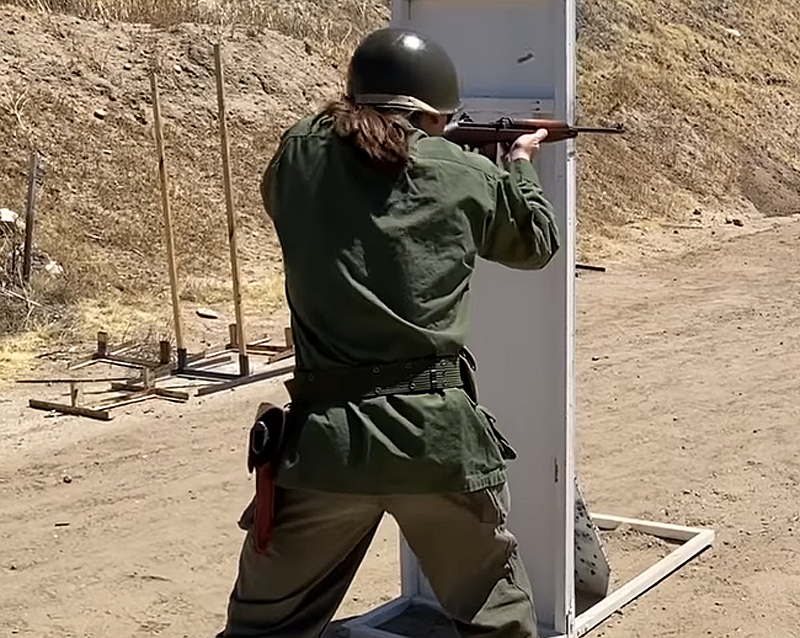
Ian McCollum of Forgotten Weapons [YouTube channel] covers all that across several videos, including the fact that World War I German casualty reports showed that the 1911 didn’t cause many of those casualties. A handgun just isn’t much good past 25 or maybe 50 yards, and even then, it requires a lot of training to shoot effectively at those distances.
So, the Army requested a light, compact semi-automatic rifle to issue to truck drivers, engineers, mortar and artillery crews, and others in place of the 1911. The M-1 carbine was the product of that request and was intended to have a 200-to-300-yard effective range, though many will say the latter number is questionable at best.
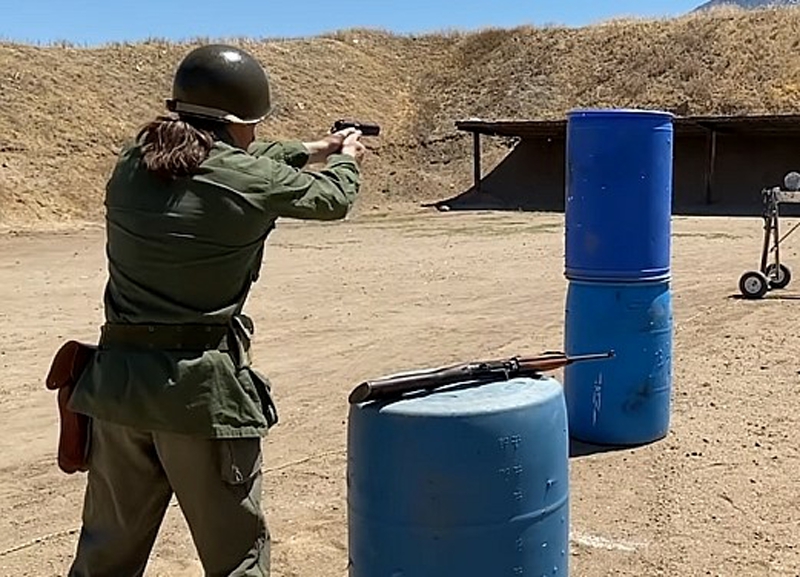
Stacking Them Up
In the video linked below, Ian fires the two weapons head-to-head on a range set up for a backup pistol course. That’s perfect since that was the intended purpose of the carbine and, obviously, the 1911. The course of fire is designed for close range and a relatively low round count.
There are four stages, which I’ll break down individually below. Scoring is simple: Targets are worth 7 points if they fall or 3 points per hit if they don’t, with a maximum of 7 points either way. The number of seconds required to hit the targets is subtracted from that total to get the score for that stage. The scores from each stage are tallied up at the end to get the final score.
The guns begin each stage in “Condition 3.” A loaded magazine is inserted but the chamber is empty, which requires the shooter to chamber a round as part of the drill. Each stage begins with the 1911 in a flap holster on the shooter’s belt or the carbine on a nearby table.
Stage 1
The Targets: Three steel silhouettes set up at what looks like ten yards.
The course of Fire: The shooter begins facing away from the targets and must hit each one twice. Reloading is allowed if necessary.

1911 Results: 7 seconds; 18 points. Score: 11
M-1 Carbine Results: 5 seconds; 18 points. Score: 13
Ian notes that the carbine is “substantially faster.”

Stage 2
The Targets: Three small falling plate targets to simulate greater distance. Two are behind barrels. Actual ranges look to be 15 to 20 yards.
The course of Fire: All shots must be made between the two barrels. The shooter is required to move up to acquire the second and third targets after hitting the first target.
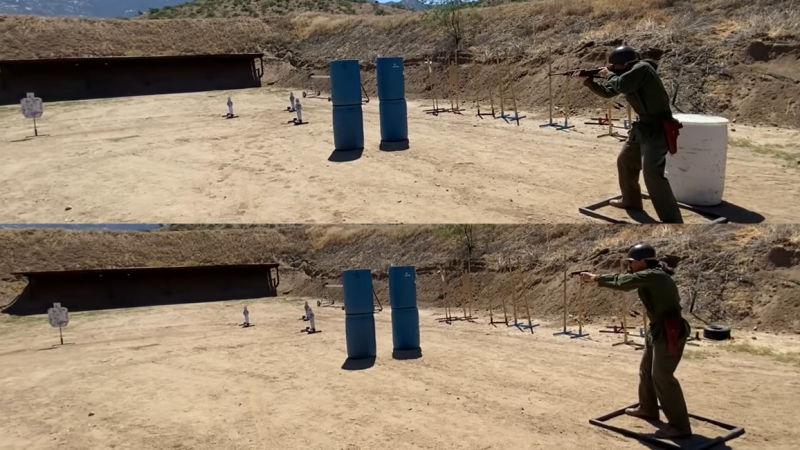
1911 Results: 9 seconds; 21 points. Score: 12
M-1 Carbine Results: 8 seconds; 21 points. Score: 13
Ian requires an extra shot with the carbine because he mistakes the front sight protector for the sight itself, causing him to miss. The carbine is still faster than the 1911.
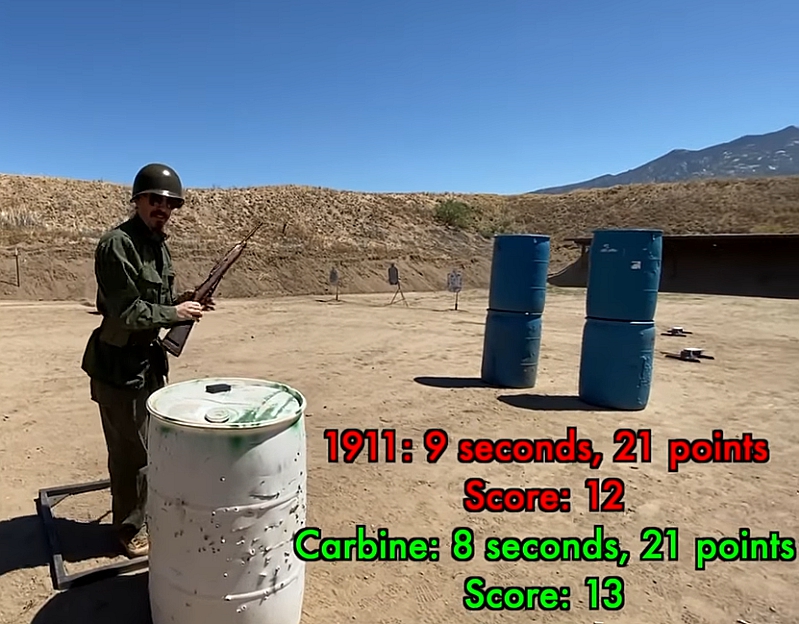
Stage 3
The Targets: One silhouette target and one smaller target at about 10 yards. One small falling plate at about 20 yards.
The Course of Fire: The shooter begins behind a small partition and must engage the first target from the right, then the second target from left side of that partition. Those targets require two hits each. The shooter may move up to the line of the first two targets to engage the last target, which is smaller, but this is not required. The last target must be hit once.
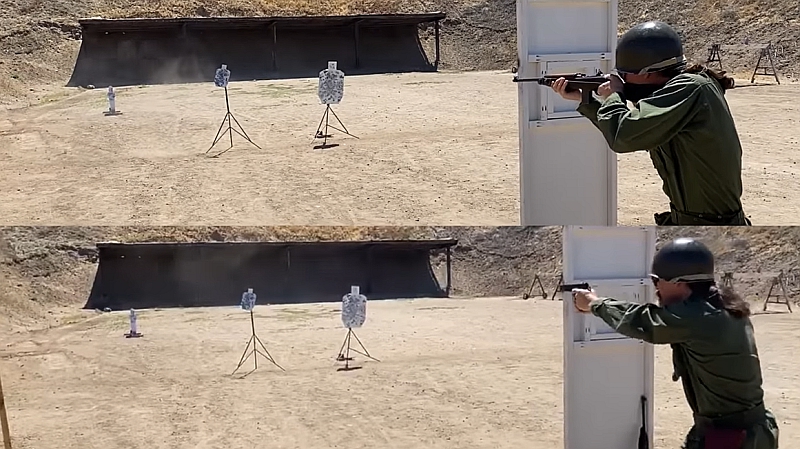
1911 Results: 8 seconds; 19 points. Score: 11
M-1 Carbine Results: 8 seconds; 19 points. Score: 11
The stage is a tie in terms of numbers, but Ian gets confused with the carbine and goes to the wrong side of the partition on the second shot, requiring more movement and at least an additional second. He also has to fire an extra shot. “That says something for the carbine,” he says, “You don’t have to be as careful.”

Stage 4
The Targets: A plate rack of five targets. Only the two outside plates can be seen from the start point thanks to barrels stacked up in the line of sight.
The Course of Fire: The shooter can hit the two outer plates from the start point but is required to retreat at an angle to acquire and engage the inner three targets. This stage simulates distance and Ian expects the carbine to separate itself from the 1911 here.

1911 Results: 15 seconds; 35 points. Score: 20
M-1 Carbine Results: 8 seconds; 35 points. Score: 27
Ian requires seven rounds from the 1911 to complete this stage, while he only needs five for the carbine, which really isn’t a surprise, given that rifles are generally easier to score hits with at distance. Ian needs almost twice as much time with the 1911 because shooting a pistol at distance requires more careful aiming, despite the fact that he’s a skilled shooter.
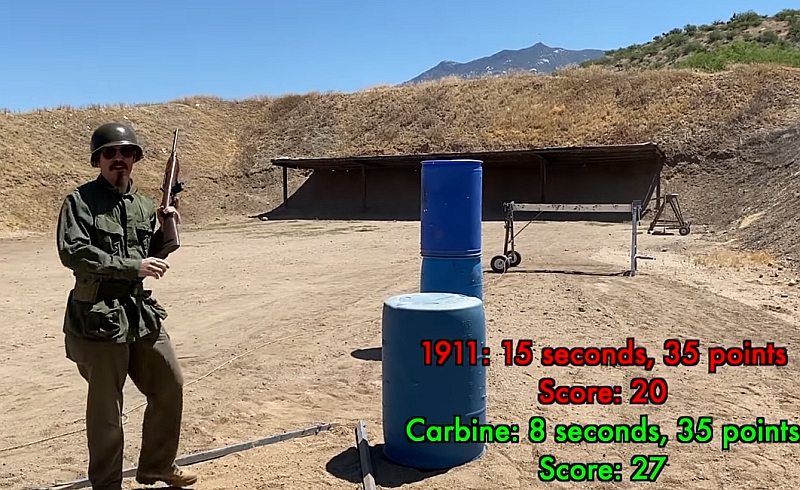
Conclusions
“That is,” Ian says, “I think, a pretty good demonstration of the purpose of the M-1 carbine. This was not meant to be a battle rifle. This wasn’t intended to replace the M-1 Garand. This was intended to be something you could use more effectively with less training than a 1911 pistol. I think it does that really well.”

And yes, we all know the carbine’s reputation for being weak. But it must also be noted that a .45 doesn’t do a damn thing if you can’t hit your target. Better a .30 carbine round hitting an enemy soldier than a .45 slug flying past him. That’s what the carbine was for.
Does this change, or maybe confirm, your opinion of the M-1 carbine? Did you have an opinion at all? Hit us up in the comments. Happy shooting, y’all.


